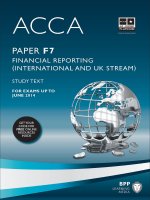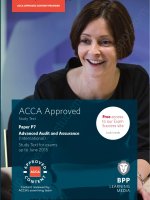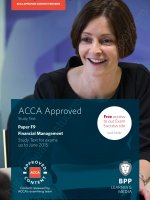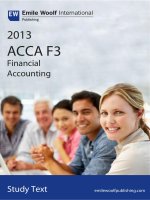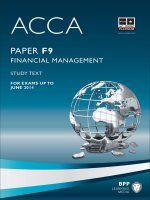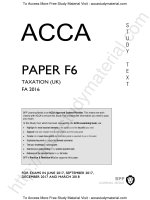ACCA f7 KAPLAN STUDY TEXT 2021 2022
Bạn đang xem bản rút gọn của tài liệu. Xem và tải ngay bản đầy đủ của tài liệu tại đây (19.29 MB, 748 trang )
FREE ACCA KAPLAN EXAM KIT 2017-2018 Click for Download
ACCA
Paper F7
Financial Reporting
Complete Text
FREE ACCA KAPLAN EXAM KIT 2017-2018 Click for Download
FREE ACCA KAPLAN EXAM KIT 2017-2018 Click for Download
British library cataloguinginpublication data
A catalogue record for this book is available from the British Library.
Published by:
Kaplan Publishing UK
Unit 2 The Business Centre
Molly Millars Lane
Wokingham
Berkshire
RG41 2QZ
ISBN 9781784156794
© Kaplan Financial Limited, 2016
The text in this material and any others made available by any Kaplan Group company does not
amount to advice on a particular matter and should not be taken as such. No reliance should be
placed on the content as the basis for any investment or other decision or in connection with any
advice given to third parties. Please consult your appropriate professional adviser as necessary.
Kaplan Publishing Limited and all other Kaplan group companies expressly disclaim all liability to any
person in respect of any losses or other claims, whether direct, indirect, incidental, consequential or
otherwise arising in relation to the use of such materials.
Printed and bound in Great Britain
Acknowledgements
We are grateful to the Association of Chartered Certified Accountants and the Chartered Institute of
Management Accountants for permission to reproduce past examination questions. The answers
have been prepared by Kaplan Publishing.
All rights reserved. No part of this publication may be reproduced, stored in a retrieval system, or
transmitted, in any form or by any means, electronic, mechanical, photocopying, recording or
otherwise, without the prior written permission of Kaplan Publishing.
ii
KAPLAN PUBLISHING
FREE ACCA KAPLAN EXAM KIT 2017-2018 Click for Download
FREE ACCA KAPLAN EXAM KIT 2017-2018 Click for Download
Contents
Page
Chapter 1
Introduction to published accounts
Chapter 2
Tangible noncurrent assets
23
Chapter 3
Intangible assets
63
Chapter 4
Impairment of assets
79
Chapter 5
Noncurrent assets held for sale and
discontinued operations
99
Chapter 6
A conceptual and regulatory framework
117
Chapter 7
Conceptual framework: Measurement of items
145
Chapter 8
Other standards
161
Chapter 9
Leases
185
Chapter 10
Financial assets and financial liabilities
211
Chapter 11
Foreign currency
251
Chapter 12
Revenue
263
Chapter 13
Taxation
303
Chapter 14
Earnings per share
331
Chapter 15
IAS 37 and IAS 10
365
Chapter 16
Principles of consolidated financial statements
393
Chapter 17
Consolidated statement of financial position
407
Chapter 18
Consolidated statement of profit or loss
467
Chapter 19
Associates
501
Chapter 20
Group disposals
543
Chapter 21
Interpretation of financial statements
563
Chapter 22
Statement of cash flows
631
Chapter 23
Appendix 1: Published financial statements
689
KAPLAN PUBLISHING
1
FREE ACCA KAPLAN EXAM KIT 2017-2018 Click for Download
iii
FREE ACCA KAPLAN EXAM KIT 2017-2018 Click for Download
Chapter 24
iv
Appendix 2: Objective case questions
725
KAPLAN PUBLISHING
FREE ACCA KAPLAN EXAM KIT 2017-2018 Click for Download
chapter
FREE ACCA KAPLAN EXAM KIT 2017-2018 Click for Download
Intro
Paper Introduction
FREE ACCA KAPLAN EXAM KIT 2017-2018 Click for Download
v
FREE ACCA KAPLAN EXAM KIT 2017-2018 Click for Download
How to Use the Materials
These Kaplan Publishing learning materials have been carefully designed to
make your learning experience as easy as possible and to give you the best
chances of success in your examinations.
The product range contains a number of features to help you in the study
process. They include:
(1) Detailed study guide and syllabus objectives
(2) Description of the examination
(3) Study skills and revision guidance
(4) Complete text
(5) Question practice
The sections on the study guide, the syllabus objectives, the examination
and study skills should all be read before you commence your studies. They
are designed to familiarise you with the nature and content of the
examination and give you tips on how to best to approach your learning.
The Complete Text comprises the main learning materials and gives
guidance as to the importance of topics and where other related resources
can be found. Each chapter includes:
vi
•
The learning objectives contained in each chapter, which have been
carefully mapped to the examining body's own syllabus learning
objectives or outcomes. You should use these to check you have a clear
understanding of all the topics on which you might be assessed in the
examination.
•
The chapter diagram provides a visual reference for the content in the
chapter, giving an overview of the topics and how they link together.
•
The content for each topic area commences with a brief explanation or
definition to put the topic into context before covering the topic in detail.
You should follow your studying of the content with a review of the
illustration/s. These are worked examples which will help you to
understand better how to apply the content for the topic.
•
Test your understanding sections provide an opportunity to assess
your understanding of the key topics by applying what you have learned
to short questions. Answers can be found at the back of each chapter.
KAPLAN PUBLISHING
FREE ACCA KAPLAN EXAM KIT 2017-2018 Click for Download
FREE ACCA KAPLAN EXAM KIT 2017-2018 Click for Download
•
Summary diagrams complete each chapter to show the important
links between topics and the overall content of the paper. These
diagrams should be used to check that you have covered and
understood the core topics before moving on.
Quality and accuracy are of the utmost importance to us so if you spot an
error in any of our products, please send an email to
with full details, or follow the link to the
feedback form in MyKaplan.
Our Quality Coordinator will work with our technical team to verify the error
and take action to ensure it is corrected in future editions.
Icon Explanations
Definition – Key definitions that you will need to learn from the core content.
Key point – Identifies topics that are key to success and are often
examined.
New – Identifies topics that are brand new in papers that build on, and
therefore also contain, learning covered in earlier papers.
Expandable text – Expandable text provides you with additional
information about a topic area and may help you gain a better
understanding of the core content. Essential text users can access this
additional content online (read it where you need further guidance or skip
over when you are happy with the topic).
Test your understanding – Exercises for you to complete to ensure that
you have understood the topics just learned.
Illustration – Worked examples help you understand the core content
better.
Tricky topic – When reviewing these areas care should be taken and all
illustrations and Test your understanding exercises should be completed to
ensure that the topic is understood.
Tutorial note – Included to explain some of the technical points in more
detail.
Footsteps – Helpful tutor tips.
KAPLAN PUBLISHING
FREE ACCA KAPLAN EXAM KIT 2017-2018 Click for Download
vii
FREE ACCA KAPLAN EXAM KIT 2017-2018 Click for Download
Online subscribers
Our online resources are designed to increase the flexibility of your learning
materials and provide you with immediate feedback on how your studies
are progressing.
If you are subscribed to our online resources you will find:
(1) Online referenceware: reproduces your Complete or Essential Text on
line, giving you anytime, anywhere access.
(2) Online testing: provides you with additional online objective testing so
you can practice what you have learned further.
(3) Online performance management: immediate access to your online
testing results. Review your performance by key topics and chart your
achievement through the course relative to your peer group.
Ask your local customer services staff if you are not already a subscriber
and wish to join.
Paper background
The aim of ACCA Paper F7, Financial Reporting, is to develop
knowledge and skills in understanding and applying accounting standards
and the theoretical framework in the preparation of financial statements of
entities, including groups and how to analyse and interpret those financial
statements.
Syllabus
Objectives of the syllabus
viii
•
Discuss and apply a conceptual and regulatory framework for financial
reporting.
•
Account for transactions in accordance with International accounting
standards.
•
•
Analyse and interpret financial statements.
Prepare and present financial statements for single entities and
business combinations which conform with International Financial
Reporting Standards.
KAPLAN PUBLISHING
FREE ACCA KAPLAN EXAM KIT 2017-2018 Click for Download
FREE ACCA KAPLAN EXAM KIT 2017-2018 Click for Download
Core areas of the syllabus
•
•
•
•
•
A conceptual framework for financial reporting.
A regulatory framework for financial reporting.
Financial statements.
Business combinations.
Analysing and interpreting financial statements.
Syllabus objectives and chapter references
We have reproduced the ACCA’s syllabus from September 16 to June 17.
Below shows where the objectives are explored within this book. Within the
chapters, we have broken down the extensive information found in the
syllabus into easily digestible and relevant sections, called Content
Objectives. These correspond to the objectives at the beginning of each
chapter.
A A CONCEPTUAL FRAMEWORK FOR FINANCIAL REPORTING
1 The need for a conceptual framework
(a) Describe what is meant by a conceptual framework of accounting.
[2] Ch. 6
(b) Discuss whether a conceptual framework is necessary and what an
alternative system might be.[2] Ch. 6
(c) Discuss what is meant by relevance and faithful representation and
describe the qualities that enhance these characteristics.[2] Ch. 6
(d) Discuss whether faithful representation constitutes more than
compliance with accounting standards.[1] Ch. 6
(e) Discuss what is meant by understandability and verifiability in relation to
the provision of financial information.[2] Ch. 6
(f)
Discuss the importance of comparability and timeliness to users of
financial statements.[2] Ch. 6
(g) Discuss the principle of comparability in accounting for changes in
accounting policies. [2] Ch. 8
KAPLAN PUBLISHING
FREE ACCA KAPLAN EXAM KIT 2017-2018 Click for Download
ix
FREE ACCA KAPLAN EXAM KIT 2017-2018 Click for Download
2 Recognition and measurement
(a) Define what is meant by ‘recognition’ in financial statements and
discuss the recognition criteria.[2] Ch. 6
(b) Apply the recognition criteria to:[2] Ch. 6
(i) assets and liabilities
(ii) income and expenses.
(c) Explain the following measures and compute amounts using:[2] Ch. 7
(i) historical cost
(ii) fair value/current cost
(iii) net realisable value
(iv) present value of future cash flows.
(v) fair value
(d) Discuss the advantages and disadvantages of the use of historical cost
accounting.[2] Ch. 7
(e) Discuss whether the use of current value accounting overcomes the
problems of historical cost accounting.[2] Ch. 7
(f)
Describe the concept of financial and physical capital maintenance and
how this affects the determination of profits.[1] Ch. 7
3 Regulatory framework
(a) Explain why a regulatory framework is needed, including the
advantages and disadvantages of IFRS over a national regulatory
framework.[2] Ch. 6
(b) Explain why accounting standards on their own are not a complete
regulatory framework.[2] Ch. 6
(c) Distinguish between a principles based and a rules based framework
and discuss whether they can be complementary.[1] Ch. 6
(d) Describe the IASB’s standard setting process including revisions to
and interpretations of standards.[2] Ch. 6
(e) Explain the relationship of national standard setters to the IASB in
respect of the standard setting process.[2] Ch. 6
x
KAPLAN PUBLISHING
FREE ACCA KAPLAN EXAM KIT 2017-2018 Click for Download
FREE ACCA KAPLAN EXAM KIT 2017-2018 Click for Download
4 The concepts and principles of groups and consolidated financial
statements
(a) Describe the concept of a group as a single economic unit. [2] Ch.16
(b) Explain and apply the definition of a subsidiary within relevant
accounting standards.[2] Ch.16
(c) Using accounting standards and other regulation, identify and outline
the circumstances in which a group is required to prepare consolidated
financial statements. [2] Ch.16
(d) Describe the circumstances when a group may claim exemption from
the preparation of consolidated financial statements. [2] Ch.16
(e) Explain why directors may not wish to consolidate a subsidiary and
when this is permitted by accounting standards and other applicable
regulation. [2] Ch.16
(f)
Explain the need for using coterminous year ends and uniform
accounting policies when preparing consolidated financial statements.
[2] Ch.16
(g) Explain why it is necessary to eliminate intra group transactions. [2]
Ch.16
(h) Explain the objective of consolidated financial statements. [2] Ch.16
(i) Explain why it is necessary to use fair values for the consideration for an
investment in a subsidiary together with the fair values of a subsidiary's
identifiable assets and liabilities when preparing consolidated financial
statements. [2] Ch.17
(j)
Define an associate and explain the principles and reasoning for the
use of equity accounting. [2] Ch.19
B ACCOUNTING FOR TRANSACTIONS IN FINANCIAL
STATEMENTS
1 Tangible noncurrent assets
(a) Define and compute the initial measurement of a noncurrent asset
(including borrowing costs and an asset that has been selfconstructed).
[2] Ch. 2
(b) Identify subsequent expenditure that may be capitalised, distinguishing
between capital and revenue items.[2] Ch. 2
(c) Discuss the requirements of relevant accounting standards in relation to
the revaluation of noncurrent assets.[2] Ch. 2
(d) Account for revaluation and disposal gains and losses for noncurrent
assets.[2] Ch. 2
KAPLAN PUBLISHING
FREE ACCA KAPLAN EXAM KIT 2017-2018 Click for Download
xi
FREE ACCA KAPLAN EXAM KIT 2017-2018 Click for Download
(e) Compute depreciation based on the cost and revaluation models and
on assets that have two or more significant parts (complex assets) [2]
Ch. 2
(f) Discuss why the treatment of investment properties should differ from
other properties.[2] Ch. 2
(g) Apply the requirements of relevant accounting standards to an
investment property.[2] Ch. 2
2 Intangible assets
(a) Discuss the nature and accounting treatment of internally generated and
purchased intangibles.[2] Ch. 3
(b) Distinguish between goodwill and other intangible assets.[2] Ch. 3
(c) Describe the criteria for the initial recognition and measurement of
intangible assets.[2] Ch. 3
(d) Describe the subsequent accounting treatment, including the principle
of impairment tests in relation to goodwill.[2] Ch. 3, Ch. 17
(e) Indicate why the value of purchase consideration for an investment may
be less than the value of the acquired identifiable net assets and how
the difference should be accounted for.[2] Ch. 17
(f)
Describe and apply the requirements of relevant accounting standards
to research and development expenditure.[2] Ch. 3
3 Impairment of assets
(a) Define and calculate an impairment loss.[2] Ch. 4
(b) Identify the circumstances that may indicate impairments to assets.
[2] Ch. 4
(c) Describe what is meant by a cash generating unit.[2] Ch. 4
(d) State the basis on which impairment losses should be allocated, and
allocate an impairment loss to the assets of a cash generating unit.[2]
Ch. 4
4 Inventory and biological assets
(a) Describe and apply the principles of inventory valuation.[2] Ch. 8
(b) Apply the requirements of relevant accounting standards for biological
assets. [2] Ch. 8
xii
KAPLAN PUBLISHING
FREE ACCA KAPLAN EXAM KIT 2017-2018 Click for Download
FREE ACCA KAPLAN EXAM KIT 2017-2018 Click for Download
5 Financial instruments
(a) Explain the need for an accounting standard on financial instruments.
[1] Ch. 10
(b) Define financial instruments in terms of financial assets and financial
liabilities.[1] Ch. 10
(c) Explain and account for the factoring of receivables.[1] Ch. 10
(d) Indicate for the following categories of financial instruments how they
should be measured and how any gains and losses from subsequent
measurement should be treated in the financial statements:[1] Ch. 10
(i) amortised cost
(ii) fair value through other comprehensive income (including where an
irrevocable election has been made for equity investments that are
not held for trading).
(iii) fair value through profit or loss
(e) Distinguish between debt and equity capital.[2] Ch. 10
(f)
Apply the requirements of relevant accounting standards to the issue
and finance costs of:[2] Ch. 10
(i) equity
(ii) redeemable preference shares and debt instruments with no
conversion rights (principle of amortised cost).
(iii) convertible debt
6 Leasing
(a) Explain why recording the legal form of a finance lease can be
misleading to users (referring to the commercial substance of such
leases).[2] Ch. 9
(b) Describe and apply the method of determining a lease type (i.e. an
operating or finance lease).[2] Ch. 9
(c) Discuss the effect on the financial statements of a finance lease being
incorrectly treated as an operating lease.[2] Ch. 9, Ch. 16
(d) Account for assets financed by finance leases in the records of the
lessee.[2] Ch. 9
(e) Account for operating leases in the records of the lessee.[2] Ch. 9
(f)
Account for sale and leaseback agreements. Ch. 9
KAPLAN PUBLISHING
FREE ACCA KAPLAN EXAM KIT 2017-2018 Click for Download
xiii
FREE ACCA KAPLAN EXAM KIT 2017-2018 Click for Download
7 Provisions and events after the reporting period
(a) Explain why an accounting standard on provisions is necessary.[2]
Ch. 15
(b) Distinguish between legal and constructive obligations.[2] Ch. 15
(c) State when provisions may and may not be made and demonstrate how
they should be accounted for.[2] Ch. 15
(d) Explain how provisions should be measured.[1] Ch. 15
(e) Define contingent assets and liabilities and describe their accounting
treatment and required disclosures.[2] Ch. 15
(f)
Identify and account for: [2] Ch. 15
(i) warranties/guarantees
(ii) onerous contracts
(iii) environmental and similar provisions
(iv) provisions for future repairs or refurbishments
(g) distinguish between and account for:
(i) adjusting and nonadjusting events after the reporting date.[2] Ch. 15
(ii) identify items requiring separate disclosure, including their accounting
treatment and required disclosures[2] Ch. 15
8 Taxation
(a) Account for current taxation in accordance with relevant accounting
standards.[2] Ch. 13
(b) Explain the effect of taxable temporary differences on accounting and
taxable profits.[2] Ch. 13
(c) Compute and record deferred tax amounts in the financial statements.
[2] Ch. 13
9 Reporting financial performance
(a) Discuss the importance of identifying and reporting the results of
discontinued operations.[2] Ch. 5
(b) Define and account for noncurrent assets held for sale and
discontinued operations. [2] Ch. 5
(c) Indicate the circumstances where separate disclosure of material items
of income and expense is required.[2] Ch. 1, Ch. 5
(d) Account for changes in accounting estimates, changes in accounting
policy and correction of prior period errors.[2] Ch. 8
xiv
KAPLAN PUBLISHING
FREE ACCA KAPLAN EXAM KIT 2017-2018 Click for Download
FREE ACCA KAPLAN EXAM KIT 2017-2018 Click for Download
(e) Earnings per share (EPS)
(i) calculate the EPS in accordance with relevant accounting
standards (dealing with bonus issues, full market value issues and
rights issues).[2] Ch. 14
(ii) explain the relevance of the diluted EPS and calculate the diluted
EPS involving convertible debt and share options (warrants).[2]
Ch. 14
10 Revenue
(a) Explain and apply the principles of recognition of revenue:
(i) identification of contracts Ch. 12
(ii) identification of performance obligations Ch. 12
(iii) determination of transaction price Ch. 12
(iv) allocation of the price to performance obligations Ch. 12
(v) recognition of revenue when/as performance obligations are
satisfied Ch. 12
(b) Explain and apply the criteria for recognising revenue generated from
contracts where performance obligations are satisfied over time or at a
point in time.[2] Ch. 12
(c) Describe the acceptable methods for measuring progress towards
complete satisfaction of a performance obligation.[2] Ch. 12
(d) Explain and apply the criteria for the recognition of contract costs.[2]
Ch. 12
(e) Apply the principles of recognition of revenue, and specifically account
for the following types of transaction:[2] Ch. 12
(i) principle versus agent
(ii) repurchase agreements
(iii) bill and hold arrangements
(iv) consignments
(f)
Prepare financial statement extracts for contracts where performance
obligations are satisfied over time.[2] Ch. 12
11 Government grants
(a) Apply the provisions of relevant accounting standards in relation to
accounting for government grants.[2] Ch. 2
KAPLAN PUBLISHING
FREE ACCA KAPLAN EXAM KIT 2017-2018 Click for Download
xv
FREE ACCA KAPLAN EXAM KIT 2017-2018 Click for Download
12 Foreign currency transactions
(a) Explain the difference between functional and presentation currency
and explain why adjustments for foreign currency transactions are
necessary.[2] Ch. 11
(b) Account for the translation of foreign currency transactions and
monetary/nonmonetary foreign currency items at the reporting date.[2]
Ch. 11
C ANALYSING AND INTERPRETING THE FINANCIAL STATEMENTS
OF SINGLE ENTITIES AND GROUPS
1 Limitations of financial statements
(a) Indicate the problems of using historic information to predict future
performance and trends.[2] Ch. 21
(b) Discuss how financial statements may be manipulated to produce a
desired effect (creative accounting, window dressing).[2] Ch. 21
(c) Explain why figures in a statement of financial position may not be
representative of average values throughout the period for example,
due to:
(i) seasonal trading
(ii) major asset acquisitions near the end of the accounting period.[2]
Ch. 21
(d) Explain how the use of consolidated financial statements might limit
interpretation techniques. [2] Ch. 21, Ch. 17, Ch. 18
2 Calculation and interpretation of accounting ratios and trends to
address users’ and stakeholders’ needs
(a) Define and compute relevant financial ratios.[2] Ch. 21
(b) Explain what aspects of performance specific ratios are intended to
assess.[2] Ch. 21
(c) Analyse and interpret ratios to give an assessment of an
entity’s/group's performance and financial position in comparison with:
[2] Ch. 21
(i) previous period’s financial statements
(ii) another similar entity/group for the same reporting period
(iii) industry average ratios.
(d) Interpret an entity’s financial statements to give advice from the
perspectives of different stakeholders.[2] Ch. 21
xvi
KAPLAN PUBLISHING
FREE ACCA KAPLAN EXAM KIT 2017-2018 Click for Download
FREE ACCA KAPLAN EXAM KIT 2017-2018 Click for Download
(e) Discuss how the interpretation of current value based financial
statements would differ from those using historical cost based
accounts.[1] Ch. 21
3 Limitations of interpretation techniques
(a) Discuss the limitations in the use of ratio analysis for assessing
corporate performance.[2] Ch. 21
(b) Discuss the effect that changes in accounting policies or the use of
different accounting policies between entities can have on the ability to
interpret performance.[2] Ch. 21
(c) Indicate other information, including nonfinancial information, that may
be of relevance to the assessment of an entity’s performance.[2] Ch. 21
(d) Compare the usefulness of cash flow information with that of a
statement of profit or loss or a statement of profit or loss and other
comprehensive income.[2] Ch. 22
(e) Interpret a statement of cash flows (together with other financial
information) to assess the performance and financial position of an
entity.[2] Ch. 22
(f)
(i) explain why the trend of EPS may be a more accurate indicator of
performance than a company's profit trend and the importance of
EPS as a stock market indicator.[2] Ch. 14
(ii) discuss the limitations of using EPS as a performance measure.[2]
Ch. 14
4 Specialised, notforprofit and public sector entities
(a) Explain how the interpretation of the financial statement of a
specialised, notforprofit or public sector organisation might differ from
that of a profit making entity by reference to the different aims,
objectives and reporting requirements. [1] Chs. 6 & 21
D PREPARATION OF FINANCIAL STATEMENTS
1 Preparation of single entity financial statements
(a) Prepare an entity's statement of financial position and statement of
profit or loss and other comprehensive income in accordance with the
structure and content prescribed and with accounting treatments as
identified within A, B and C. Ch. 1
(b) Prepare and explain the contents and purpose of the statement of
changes in equity. Ch. 1
(c) Prepare a statement of cash flows for a single entity (not a group) in
accordance with relevant accounting standards using the direct and the
indirect method.[2] Ch. 22
KAPLAN PUBLISHING
FREE ACCA KAPLAN EXAM KIT 2017-2018 Click for Download
xvii
FREE ACCA KAPLAN EXAM KIT 2017-2018 Click for Download
2 Preparation of consolidated financial statements including an
associate
(a) Prepare a consolidated statement of financial position for a simple
group (parent and one subsidiary and associate) dealing with pre and
postacquisition profits, noncontrolling interests and consolidated
goodwill.[2] Chs. 17 & 19
(b) Prepare a consolidated statement of profit or loss and consolidated
statement of profit or loss and other comprehensive income for a
simple group dealing with an acquisition in the period and non
controlling interest.[2] Chs. 18 & 28
(c) Explain and account for other reserves (e.g. share premium and
revaluation reserves).[1] Ch. 17
(d) Account for the effects in the financial statements of intragroup trading.
[2] Chs. 17 & 19
(e) Account for the effects of fair value adjustments (including their effect on
consolidated goodwill) to:[2] Chs. 17 & 18
(i) depreciating and nondepreciating noncurrent assets
(ii) inventory
(iii) monetary liabilities
(iv) assets and liabilities not included in the subsidiary’s own statement
of financial position, including contingent assets and liabilities
(f)
Account for goodwill impairment.[2] Chs. 17 & 18
(g) Describe and apply the required accounting treatment of consolidated
goodwill.[2] Chs. 17 & 18
(h) Explain and illustrate the effect of a disposal of a parent's investment in
a subsidiary in the parent's individual financial statements and/or those
of the group (restricted to disposals of the parent's entire investment in
the subsidiary). Ch. 20
The numbers in square brackets indicate the intellectual depth at which the
subject area could be assessed within the examination. Level 1 (knowledge
and comprehension) broadly equates with the Knowledge module, Level 2
(application and analysis) with the Skills module and Level 3 (synthesis and
evaluation) to the Professional level. However, lower level skills can continue
to be assessed as you progress through each module and level.
xviii
KAPLAN PUBLISHING
FREE ACCA KAPLAN EXAM KIT 2017-2018 Click for Download
FREE ACCA KAPLAN EXAM KIT 2017-2018 Click for Download
The Examination
Examination format
The syllabus is assessed by a threehour 15 minute examination. All
questions are compulsory. It will contain both computational and discursive
elements.
Some questions will adopt a scenario/case study approach.
Section A of the exam comprises 15 objective test (OT) questions of 2
marks each.
Section B of the exam comprises three objective case questions (OT
cases) worth 10 marks each. Each case has five objective test questions of
2 marks each.
Section C of the exam comprises two constructed response questions,
worth 20 marks each.
The 20 mark questions will examine the interpretation and preparation of
financial statements for either a single entity or a group. The section A and
section B questions can cover any areas of the syllabus.
An individual question may often involve elements that relate to different
subject areas of the syllabus. For example, the preparation of an entity's
financial statements could include matters relating to several accounting
standards.
Questions may ask candidates to comment on the appropriateness or
acceptability of management's opinion or chosen accounting treatment. An
understanding of accounting principles and concepts and how these are
applied to practical examples will be tested.
Questions on topic areas that are also included in Paper F3 will be
examined at an appropriately greater depth in this paper.
Candidates will be expected to have an appreciation of the need for
specific accounting standards and why they have been issued. For detailed
or complex standards, candidates need to be aware of their principles and
key elements.
KAPLAN PUBLISHING
FREE ACCA KAPLAN EXAM KIT 2017-2018 Click for Download
xix
FREE ACCA KAPLAN EXAM KIT 2017-2018 Click for Download
Section A – Fifteen 2mark objective test questions
Section B – Three 10mark objective case questions,
comprising of five 2mark questions each
Section C – Two 20mark constructed response questions
Total time allowed: 3 hours 15 minutes
Number of
marks
30
30
40
–––
100
Examination tips
Individual students will have different approaches of how to tackle the F7
exam. Some students may wish to spend the first 15 minutes familiarising
themselves with the paper, particularly the constructed response questions.
Students who wish to do this should then allocate 1.8 minutes per mark,
meaning that a 20 mark section C question should be completed in
approximately 36 minutes, with a 10 mark section B question taking
approximately 18 minutes.
An alternative suggestion for this examination is to allocate 1.95 minutes to
each mark available, so a 20 mark section C question should be completed
in approximately 39 minutes, with a 10 mark section B question taking
approximately 19 minutes.
Unless you know exactly how to answer the question, spend some time
planning your answer. Stick to the question and tailor your answer to what
you are asked. Pay particular attention to the verbs in the question.
If you get completely stuck with a question, leave space in your answer
book and return to it later.
If you do not understand what a question is asking, state your assumptions.
Even if you do not answer in precisely the way the examiner hoped, you
should be given some credit, if your assumptions are reasonable.
You should do everything you can to make things easy for the marker. The
marker will find it easier to identify the points you have made if your answers
are legible.
Short narrative response: Your answer should be concise but specific,
explaining terms where required. Short narrative responses will often
require comment on the correct accounting treatment of items, so an ability
to discuss this is essential, rather than simply providing calculations.
Computations: It is essential to include all your workings in your answers.
Many computational questions require the use of a standard format. Be sure
you know these formats thoroughly before the exam and use the layouts that
you see in the answers given in this book and in model answers.
xx
KAPLAN PUBLISHING
FREE ACCA KAPLAN EXAM KIT 2017-2018 Click for Download
FREE ACCA KAPLAN EXAM KIT 2017-2018 Click for Download
Interpretation style response: Longer form responses are likely to
contain some form of interpreting information. A good interpretation answer
takes account of the information contained within the question and is
structured well, with good use of headings and sections.
Study skills and revision guidance
This section aims to give guidance on how to study for your ACCA exams
and to give ideas on how to improve your existing study techniques.
Preparing to study
Set your objectives
Before starting to study decide what you want to achieve – the type of pass
you wish to obtain. This will decide the level of commitment and time you
need to dedicate to your studies.
Devise a study plan
Determine which times of the week you will study.
Split these times into sessions of at least one hour for study of new material.
Any shorter periods could be used for revision or practice.
Put the times you plan to study onto a study plan for the weeks from now until
the exam and set yourself targets for each period of study – in your sessions
make sure you cover the course, course assignments and revision.
If you are studying for more than one paper at a time, try to vary your
subjects as this can help you to keep interested and see subjects as part of
wider knowledge.
When working through your course, compare your progress with your plan
and, if necessary, replan your work (perhaps including extra sessions) or, if
you are ahead, do some extra revision/practice questions.
Effective studying
Active reading
You are not expected to learn the text by rote, rather, you must understand
what you are reading and be able to use it to pass the exam and develop
good practice. A good technique to use is SQ3Rs Survey, Question,
Read, Recall, Review:
(1) Survey the chapter – look at the headings and read the introduction,
summary and objectives, so as to get an overview of what the chapter
deals with.
KAPLAN PUBLISHING
FREE ACCA KAPLAN EXAM KIT 2017-2018 Click for Download
xxi
FREE ACCA KAPLAN EXAM KIT 2017-2018 Click for Download
(2) Question – whilst undertaking the survey, ask yourself the questions
that you hope the chapter will answer for you.
(3) Read through the chapter thoroughly, answering the questions and
making sure you can meet the objectives. Attempt the exercises and
activities in the text, and work through all the examples.
(4) Recall – at the end of each section and at the end of the chapter, try to
recall the main ideas of the section/chapter without referring to the text.
This is best done after a short break of a couple of minutes after the
reading stage.
(5) Review – check that your recall notes are correct.
You may also find it helpful to reread the chapter to try to see the topic(s) it
deals with as a whole.
Notetaking
Taking notes is a useful way of learning, but do not simply copy out the text.
The notes must:
•
•
•
•
•
be in your own words
be concise
cover the key points
be wellorganised
be modified as you study further chapters in this text or in related ones.
Trying to summarise a chapter without referring to the text can be a useful
way of determining which areas you know and which you don't.
Three ways of taking notes:
Summarise the key points of a chapter.
Make linear notes – a list of headings, divided up with subheadings listing
the key points. If you use linear notes, you can use different colours to
highlight key points and keep topic areas together. Use plenty of space to
make your notes easy to use.
Try a diagrammatic form – the most common of which is a mindmap. To
make a mindmap, put the main heading in the centre of the paper and put a
circle around it. Then draw short lines radiating from this to the main sub
headings, which again have circles around them. Then continue the process
from the subheadings to subsubheadings, advantages, disadvantages,
etc.
xxii
KAPLAN PUBLISHING
FREE ACCA KAPLAN EXAM KIT 2017-2018 Click for Download
FREE ACCA KAPLAN EXAM KIT 2017-2018 Click for Download
Highlighting and underlining
You may find it useful to underline or highlight key points in your study text –
but do be selective. You may also wish to make notes in the margins.
Revision
The best approach to revision is to revise the course as you work through it.
Also try to leave four to six weeks before the exam for final revision. Make
sure you cover the whole syllabus and pay special attention to those areas
where your knowledge is weak. Here are some recommendations:
Read through the text and your notes again and condense your notes into
key phrases. It may help to put key revision points onto index cards to look
at when you have a few minutes to spare.
Review any assignments you have completed and look at where you lost
marks put more work into those areas where you were weak.
Practise exam standard questions under timed conditions. If you are short of
time, list the points that you would cover in your answer and then read the
model answer, but do try to complete at least a few questions under exam
conditions.
Also practise producing answer plans and comparing them to the model
answer.
If you are stuck on a topic find somebody (a tutor) to explain it to you.
Read good newspapers and professional journals, especially ACCA's
Student Accountant this can give you an advantage in the exam.
Ensure you know the structure of the exam – how many questions and of
what type you will be expected to answer. During your revision attempt all
the different styles of questions you may be asked.
Further reading
'A student's guide to International Financial Reporting Standards' by
Clare Finch.
'A student's guide to Preparing Financial Statements' by Sally Baker.
'A student's guide to Group Accounts' by Tom Clendon.
You can find further reading and technical articles under the student section
of ACCA's website.
KAPLAN PUBLISHING
FREE ACCA KAPLAN EXAM KIT 2017-2018 Click for Download
xxiii
FREE ACCA KAPLAN EXAM KIT 2017-2018 Click for Download
International Examinable Documents
Download FREE ACCA STUDY
MATERIALS & LSBF LECTURES
from www.accalsbfvideos.com
xxiv
KAPLAN PUBLISHING
FREE ACCA KAPLAN EXAM KIT 2017-2018 Click for Download
chapter
1
FREE ACCA KAPLAN EXAM KIT 2017-2018 Click for Download
Introduction to published
accounts
Chapter learning objectives
Upon completion of this chapter you will be able to:
•
prepare an entity’s financial statements in accordance with
prescribed structure and content
•
prepare and explain the contents and purpose of the statement of
changes in equity.
FREE ACCA KAPLAN EXAM KIT 2017-2018 Click for Download
1
